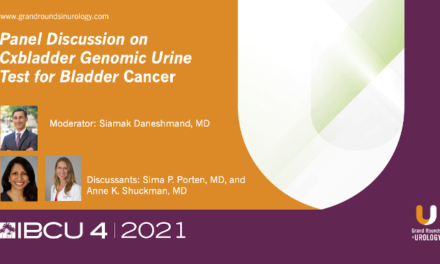Dr. Daniel Theodorescu presented “Basic Science in Bladder Cancer: What a Practicing Urologist Needs to Know in 2017” at the International Bladder Cancer Update meeting on Tuesday, January 24, 2017.
Keywords: bladder cancer, genes mutation, BCR, DNA,RNA, PCR, polymorphisms
How to cite: Theodorescu, Daniel. “Basic Science in Bladder Cancer: What a Practicing Urologist Needs to Know in 2017” January 24, 2017. Accessed Apr 2024. https://dev.grandroundsinurology.com/basic-science-bladder-cancer-practicing-urologist-needs-know-2017
Transcript
Basic Science in Bladder Cancer: What a Practicing Urologist Needs to Know in 2017
I thought I’d actually touch upon some basic science that relates to a lot of the molecular medicine that we see today in urology, and hopefully it will be of relevance to your practice.
These are my disclosures, which are also on the web
These are learning objectives. So, again going over some basic science concepts and going over some technologies, and also showing you how we can bring these technologies and concepts together. So, here are the ideas that I’m going to talk about. Basically, in the world of today in terms of personalized medicine we have some raw materials, and then we take those raw materials and we process them using a variety of technologies, and then we come up with useful tools for clinical management. So, the raw materials that the patient can offer you are these; their DNA, RNA, and then you basically do PCR, DNA sequencing, microarray expression of RNA, and I’m going to show you examples of all of these, Western blots, immunohistochemistry. And then we translate that knowledge into genes, proteins, and clinical tests, and I’m going to give you vignettes of some of these, and you’ve already heard Peter Black talking about FGFR, and these two tests here, as well as UroVysion. I’ll give you a little more in-depth knowledge on the science underlying those. And then once these tests are developed you basically have to implement them and study them in the clinical scenario and see what their characteristics are in terms of helping you manage patients.
This is a normal cell. A lot of the tests that you’re going to look at, or you have in front of you in 2017 relate really to probing aspects of the cell, specifically the cancer cell, but it’s very important to remember that we also probe the normal host, especially as you’ll see with polymorphisms and as well in the context of immuno-oncology because we’re harnessing the immune system.
This is a normal cell, which is basically a signaling entity, a signaling machine receiving signals from the outside, transducing those signals that then regulate gene expression of the promoter, making RNA. The RNA basically is translated into proteins, and proteins autoregulate this, as well as release growth factors that can stimulate itself through autoregulation or other cells through paracrine regulation. So, what happens with cancer is you can, cancer is a genetic disease, fundamentally it’s a genetic disease. So, just as a fundamental concept here anything that you think of in terms of we’re talking about biomarkers, and I’ll show you some more examples, because cancer is a genetic disease you will be able to diagnose cancer at some point 100% using noninvasive technologies. You have to be able to do this because at the root of cancer is the fact that the cancer’s DNA is not going to be the same as your DNA, the host DNA. So, as Peter showed you earlier some of the novel tests that are being put forth now are based on mutations, and that is a foregoing conclusion that these are going to, maybe they’re not going to work with this first iteration but it has to work. It’s because it’s a fundamental truism that cancer is a genetic disease. Obviously, you can see I’m a believer in the technology. And so, a lot of the things we have are basically revolving around deregulation of the circuitry of the cell.
Biologic samples could be thought of very simply, and sort of linearly, as DNA which is basically a blueprint. Okay? DNA is a static thing, except in cancer of course it can change. Then this DNA produces RNA. So, if the DNA is a blueprint the RNA is really the plane its built, and the plane also could be, you can argue that it’s the RNA and the protein that is the plane. And the metabolic processes of the cell, of the cancer, is really, there was a video here showing the Wright brothers, so this is the Wright brothers’ plane, and basically the plane flying because you could look at the plane, you could see it, touch it, but you don’t know if it flies. I mean it could sink like a rock. So, metabolic processes are even more complicated because for every copy of a gene you could have multiple pieces of RNA that get made, and out of each RNA multiple proteins can be made because of all subsequent changes at every level. So, the level of complexity increases almost exponentially between the DNA and the metabolic processes allowing the cell to finally regulate itself and balance itself. And obviously the sample types that we can process are in urology we have urine, but we have standard with all cancers blood, tumor tissue, and importantly normal tissue.
Here are some of the assays that you see in journals, that you read about in the urology literature, and first of all let me start with the germline or the host. Microarrays can look at a single nucleotide polymorphism, SNPs, and so I’ll show you examples of that in a minute. And, in terms of the tumor body fluid examination you look at RNA, a micro RNA with PCR, sequencing. You look at mutation also with sequencing. Copy numbers with things like FISH, like the UroVysion, protein expression by immunohistochemistry, and you’re familiar with that as you probably often get IHC on things like PSA potentially for trying to figure out if a tumor is prostate or bladder, if it’s at a bladder neck location, and of course, now with immuno-oncology immune profiling. And you basically put these two things together and basically bring together an analysis, the integrative analysis, and integrate all of this knowledge from the host and the tumor in order to develop prognostic, predictive markers, and among the predictive markers a subset that actually predicts a response to specific targeted agents, and these help you manage the patient. And if there is unfortunately a tumor recurrence the process gets reiterated completely because you know the old saying that what doesn’t kill me makes me stronger cancer is the same way, and the cancer actually changes after it evolves, after a failure of therapy.
Now I’m going to basically show you a little video because I think this is something that is pervasive in the literature. It’s basically one of the most important discoveries ever I think in biology because of what it did in terms of allows us to do the gene sequencing that, the Human Genome Project would not have been possible without this. I just want a quick show of hands. I was going to use ARS, but I figure you have too many slides already. A quick show of hands, who can stand right here and explain to me, explain to the group what PCR is? Okay. So, okay four people. That’s great. So, I just didn’t want to waste everybody’s time. This is a bit of an experiment to know whether this is worthwhile, but I think it may be.
VIDEO MALE VOICE: –Genomic DNA can be used as the starting material for the polymerase chain reaction, or PCR. With PCR an investigator can amplify a single copy of a DNA segment into billions of identical copies. The DNA segment of interest, or target DNA, is indicated in red. In addition to the target DNA a PCR reaction contains several other ingredients, these include free nucleotides, DNA primers, and the enzyme Taq polymerase. The primers are typically about 20 nucleotides long and are complementary in sequence to the ends of the target DNA. Taq polymerase is derived from hot springs bacteria and can tolerate the intense heat of a PCR reaction. A PCR reaction lasts several hours and typically consists of 20 to 35 repeating cycles. A cycle begins by heating the reaction mixture to 95 degrees Celsius. The heat denatures the DNA, breaking the hydrogen bonds that hold the strands together. After denaturing the DNA the temperature is reduced to around 60 degrees, so that the primers can form hydrogen bonds, or anneal with their complementary sequences in the target DNA. Note that the primers and the target DNA follow base pairing rules, and adenine (A) pairs with a thymine (T) and a cytosine (C) pairs with a guanine (G).
In the next phase the temperature is raised to 72 degrees Celsius, Taq polymerase functions optimally at this temperature, and begins polymerization, adding nucleotides to the three prime end of each primer attached to the DNA strand. After one complete cycle, there are two double-stranded copies of the target DNA.
The PCR reaction mixture contains many copies of the primers, and an abundant supply of nucleotides to perform many additional cycles. After a second cycle, there are four copies of the target DNA. After cycle three is finished, there are eight copies of the double-stranded target DNA sequence. Note that only two of the double-stranded copies consist of just the target fragment, the others also include flanking DNA regions. As the number of cycles increases the products consist of a greater proportion of–
So, I’m going to cut it off because I think the message is clear. So, essentially what this technology does is amplify the pieces of DNA, and you can imagine although at first it wasn’t, it may not be intuitively obvious what the power of this is, you could take it from me that without this we would not have been able to do the whole genome sequencing, we are not going to be able to, we would not be able to do 2,000 dollar to sequence a human cancer right now in 2017. It was all based on this technology, and obviously, refinements of that. So, it’s really fundamental.
PCR whether it’s, again and the other thing you could do with PCR is you can amplify both DNA and RNA. So, all of the tests that are looking at mutations in the urine all rely on PCR to amplify the mutations, and detect them. Otherwise you couldn’t detect them just with the DNA.
The other thing that we look at is SNPs, and these are position markers. So, polymorphisms everybody has a different polymorphic set, although everybody it looks like a human being here, not everybody has the same color eyes, color hair, etcetera. A lot of this is basically intrinsic in the polymorphisms that we all have, and the other benefit of polymorphisms is that they can track with disease predisposition. So, these studies are done with large cohorts of patients without the disease and with the disease. And in bladder cancer people have done extensive studies to identify SNPs in various positions, this is the SNP type, that increase or decrease your risk of bladder cancer. Now, it turns out that the SNPs that have been found, although they’re strongly statistically significant because the populations are so large that are studied, the problem is is that some of these risks are quite small, and get buried if you take into account smoking history, etcetera, and other exposures. So, although we cannot risk stratify very well for bladder cancer this has been shown to be useful for other cancers. And I’m showing you this in case you come across these concepts.
The other, just as a quick anecdote, the other interesting thing about SNPs, and some of you that have dogs may have already used this, is that you can actually figure out what kind of, your origin of your dog. So, I have a German Shepard and one of the things that intuitively you think, this is my dog, you think well it’s close to the wolf. Right? Well, it turns out that if you do polymorphism analysis, I didn’t do it because I knew that it’s already been done, and so if you do that on a dog it turns out that my dog is not close to the wolf, not even by a longshot. It’s actually between the Portuguese Waterdog and the Standard Schnauzer. Go figure. I mean there you go. Surprise. Looks can be deceiving. Okay? Anyway, so this is very powerful technology, primarily to really look at risk of cancers, but more and more people are using SNP analyses to look at pharmacogenomics, how you bioprocess drugs and toxins, etcetera, which is really important in terms of drug pharmacotherapy, or pharmacology and pharmacodynamics.
The other thing I wanted to cover is to show you a couple of examples of genes that could be used in the clinic, and how they’re used. So, this is a molecular genetics of bladder cancer sort of summary slide, again there are more things going on here but these are some of the key players in the two major pathways of bladder cancer, the non-muscle invasive and the invasive pathways. And these are the genes that move one pathway in some of the genes like p53 that move on the invasive pathway, the noninvasive pathway FGFR3, RAS, and PI3 kinase.
FGFR3 is a very, very interesting and important gene. You’re going to come across it in many ways, not only for therapeutics because they’re targeted agents, but also for diagnostics as you heard earlier. And so FGFR3 is a receptor and similar it’s a membrane receptor, and RAS is also another gene that’s very, very important because it’s an intracellular molecule that actually signals in three areas to three different molecules that are very important, PI3 kinase, RAF, and RAL, and a majorly mutated gene in many cancers.
FGFR3 has been originally identified mutations in this gene in achondroplasia. And what it does is that when it’s mutated it’s active and it causes fusion of the plates, the bone plates, and resulting in the phenotype. In cancer it causes growth of the cancer cell. So, there are many papers, and you have the slide so you can look at these, there are many papers that have shown that with FGFR3 mutations are associated with better prognosis in non-muscle invasive disease, and interestingly enough if you look at this, this is another study, that shows that if you look at mutations of the FGFR3 and other genes, PIK3, and p53, the profile of the recurrent tumor is the same as the mutational profile of the original tumor. And the reason why that’s important is if you go back to the idea that you can detect cancers by mutation, as you heard earlier, it’s really important that the recurrent tumor looks the same because if the recurrent tumor looks very different then you’re not going to be able to pick it up with the mutations unless you have a large panel, which we now can do. But it’s important from a biological point of view, and a clinical point of view, that the recurrent tumors are similar.
The other thing that’s interesting when people have done these kind of studies is that the mutational profile between primary tumors that are TA, T1, but low grade, is different from the high-grade non-muscle invasive disease, and the muscle invasive disease, which again highlights the idea that as you heard from Seth Lerner earlier about doing early cystectomies, if somebody looks like this as the molecular level and has failed BCG what are we waiting for? I mean they have the molecular wherewithal and the signature to basically, they’re this you just happened to get lucky and caught them early. So, if you’re not eradicating them with BCG you better move along and do a cystectomy.
This is a technology that’s called the Western Blot, and the reason why I’m showing you this is because this is really the fundamental, the great grandfather of some of the tests that you read about, and basically this is proteins that are run on a gel, and then you go in with an antibody, and you detect these bands after you transfer the gel over to a membrane. And why is this important? It’s because this technology and idea was underlying the idea of the ELISA. It’s the same idea. You have a protein and you go with an antibody, and then you have a detection antibody, and then you have this. A lot of the lab tests that you order for things like PCA, etcetera, are ELISA-based technology. So, that’s really the fundamental.
The other thing that is based on the original Western idea is the NMP22 and the BTA tests, and you’ve heard about those from Peter earlier. Again, these are all based on the fundamental idea of proteins being detected by an antibody. And you’ve heard about the FISH test. This is again, UroVysion is the tradename that you’ve heard of and that’s being used in urology and bladder cancer specifically. We’re looking at DNA probes. As you can see here, if you have a normal cell with two chromosomes with the gene on both chromosomes you look at pair colors. If you have a cancer you have multiple copies of the chromosome and you have a problem, therefore you see this and you have multiple red dots, you have more than two, and then there is a problem and that helps you make the diagnosis that it’s a cancer.
P53 is a tumor suppressor. It’s one of the very important genes in cancer. It’s one of the, it’s the or one of the most highly mutated genes in cancer overall, not just bladder, and it’s detected commonly by sequencing or immunohistochemistry. Immunohistochemistry is based also on the Western idea and a derivative if you will of the ELISA, and you basically have cells that express p53, and because the mutated p53 is more stable you have more accumulation of the antibody with the marker, therefore the nuclei are darker.
Lastly, or towards the end here is the array technologies. There are a lot of tests that are now done in array technology. This is a concept where you have basically thousands of very distinct molecules of RNA or DNA that are then, that are on the bottom–how do I go back? Okay, they’re on the bottom of this array plate and you put your sample on and then it reads out 30,000 genes information and see what the tumor is expressing. And what you can do with this kind of work in the research environment that was then taken to the clinic, is that this group about ten years ago identified the genes that are specific to various tumors, and identified for example genes that are only expressed in bladder cancer, colon, gall bladder, liver, ovary, and what this is now being used clinically is if you have a tumor of unknown primary and somebody represents with metastatic disease you could sample that tumor and it will tell you using molecule gene expression array technology where the tumor is coming from, potentially a treatable site.
Finally, next generation sequencing, I’m going to show you some more examples in the second talk, but this has been revolutionary because we’ve identified so many different genes and sites that are mutated in bladder cancer that potentially can have targeted therapeutics. And so, this is the last video. I’m already running over time. It’s about two minutes Dan. Do you want me to show it? Okay. This is basically a video showing how many of the targeted agents that we’re going to be using or you’re going to see are being developed, and how they work. This is CML with Gleevec, that I’m sure many of you are familiar with, but this is the fundamental idea behind all of these.
Basically, Gleevec is the poster child of targeted molecular therapeutics with small molecules. The same ideas that were used to basically discover Gleevec, I’ll show you that in the second talk, are being used for other drugs, basically drugs that attack a specific mutation, genetic abnormality in cancer.
And with that, I thank you for your attention.






